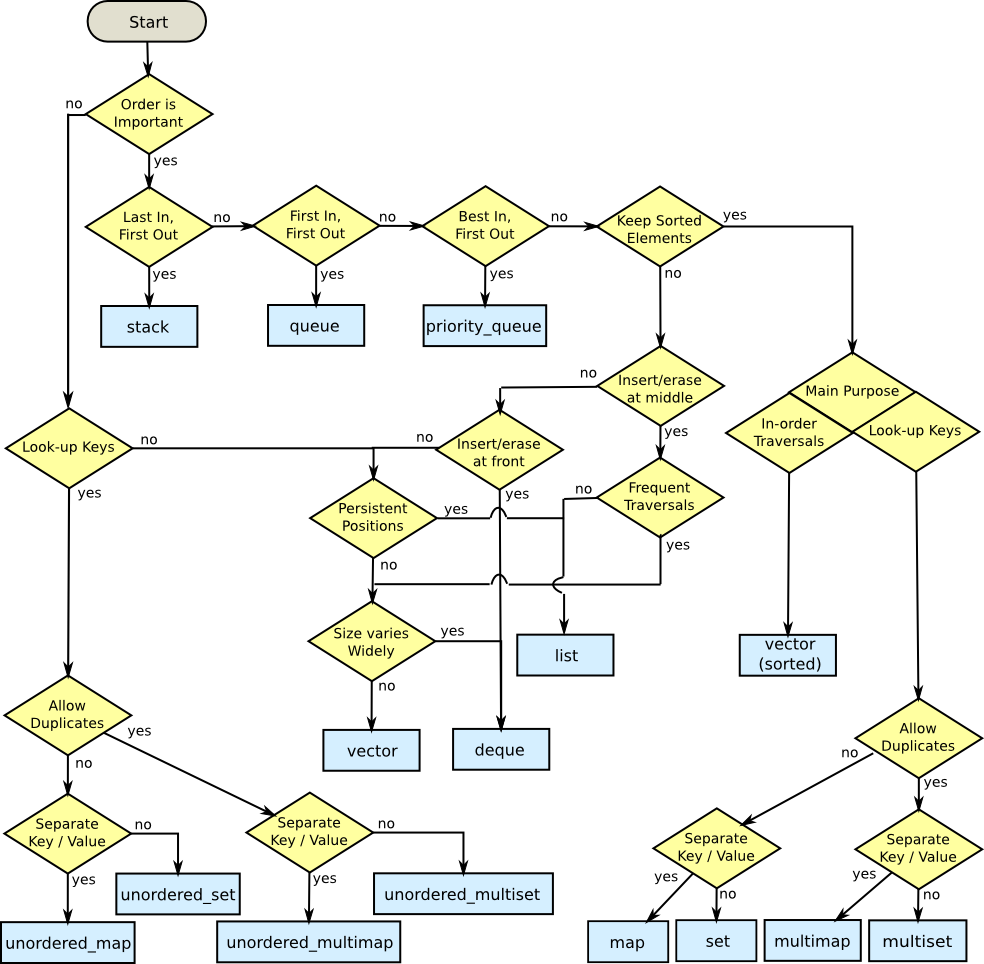如何选择合适的STL容器?
声明:这是个仁者见仁智者见智的事儿,没有正确的答案。只有适合和不适合。这是在google上扒的一张图,耐心观看:你肯定听过一本书叫《Effective STL》,我么看看Meyers大师怎么描述的:If you want to store a determined/undetermined number of objects and you’re never going to delete
声明:
这是个仁者见仁智者见智的事儿,没有正确的答案。只有适合和不适合。
这是在google上扒的一张图,耐心观看:
你肯定听过一本书叫《Effective STL》,我么看看Meyers大师怎么描述的:
If you want to store a determined/undetermined number of objects and you’re never going to delete any, then a vector is what you want. It’s the default replacement for a C array, and it works like one, but doesn’t overflow. You can set its size beforehand as well with reserve().
如果只是存储确定或不确定的objects,而不去删除它们,我们可以选用vector。就是因为vector是数组的替代品,是连续内存的,不适合频繁的删除。
If you want to store an undetermined number of objects, but you’ll be adding them and deleting them, then you probably want a list…because you can delete an element without moving any following elements - unlike vector. It takes more memory than a vector, though, and you can’t sequentially access an element.
如果频繁的插入和删除,可以选用list。也就是我们所说的链表,内存不是连续的,可以方便的插入和删除,但是不支持索引访问。
If you want to take a bunch of elements and find only the unique values of those elements, reading them all into a set will do it, and it will sort them for you as well.
If you have a lot of key-value pairs, and you want to sort them by key, then a map is useful…but it will only hold one value per key. If you need more than one value per key, you could have a vector/list as your value in the map, or use a multimap.
如果是key-value形式的,可以使用map。但是需要注意的是map的key是唯一的。
It’s not in the STL, but it is in the TR1 update to the STL: if you have a lot of key-value pairs that you’re going to look up by key, and you don’t care about their order, you might want to use a hash
数据量很大,不在乎他们的排序,那么我们可以选用hash
首先需要明确每个stl容器的数据结构、以及优缺点。
其次是要明确自己对数据的操作,数量确定还是不确定,需不需要频繁的插入和删除,需不要进行排序,需不需要进行快速的查找,以及数据量是什么级别,几千条还是百万级等等。
接下来就是完成自己的工作了。
很多时候,在stl的世界里,只有两种人,一种是使用vector,另一种是使用list。
所有的根源还是在于数组和链表的区别:
连续和非连续
快速查找和非快速查找
索引访问和非索引访问
插入效率低和插入效率高
删除效率低和删除效率高
排序效率高和排序效率低
这里补充一下map和set的区别:
说实话,在工作中我从来没有接触过set这个容器。
set (and multiset): Significant memory overhead per contained object. Use where you need to find out quickly if that container contains a given object, or merge containers efficiently.
map (and multimap): Significant memory overhead per contained object. Use where you want to store key-value pairs and look up values by key quickly.
set(集合)——包含了经过排序了的数据,这些数据的值(value)必须是唯一的。
map(映射)——经过排序了的二元组的集 合,map中的每个元素都是由两个值组成,其中的key(键值,一个map中的键值必须是唯一的)是在排序或搜索时使用,它的值可以在容器中重新获取;而 另一个值是该元素关联的数值。比如,除了可以ar[43] = “overripe”这样找到一个数据,map还可以通过ar[“banana”] = “overripe”这样的方法找到一个数据。如果你想获得其中的元素信息,通过输入元素的全名就可以轻松实现。
map是映射集合中的元素不能重复,set可以进行集合的各种操作(交并补等),当然你也可以用list或vector实现set,但是效率会很低。set一般是用平衡树或哈西表实现的。
映射是一种一一对应的关系,哈西表也可以看作是映射的一种。映射通常可用来实现字典结构(dictionary)
综上所述:
数据结构是王道
明确每个stl容器的数据结构以及优缺点
读一些stl的源码
更多推荐
 已为社区贡献3条内容
已为社区贡献3条内容










所有评论(0)